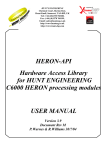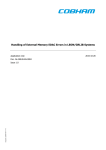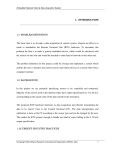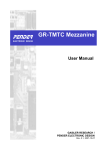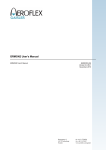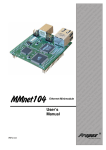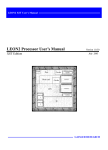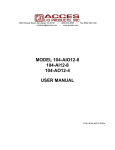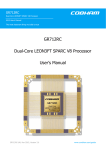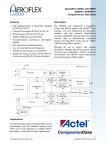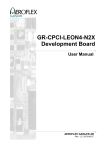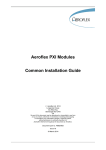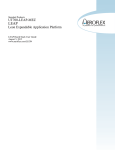Download - Aeroflex Gaisler
Transcript
SPWRTC Development Unit User Manual AEROFLEX GAISLER AB Rev. 1.1, 2008-10-28 2 SPWRTC Development Unit User Manual Information furnished by Aeroflex Gaisler AB is believed to be accurate and reliable. However, no responsibility is assumed by Aeroflex Gaisler AB for its use, nor for any infringements of patents or other rights of third parties which may result from its use. No license is granted by implication or otherwise under any patent or patent rights of Aeroflex Gaisler AB. Aeroflex Gaisler AB tel +46 31 7758650 Kungsgatan 12 fax +46 31 421407 411 19 Göteborg [email protected] Sweden www.aeroflex.com/gaisler Copyright © 2008 Aeroflex Gaisler All information is provided as is. There is no warranty that it is correct or suitable for any purpose, neither implicit nor explicit. © Aeroflex Gaisler AB October 2008, Rev. 1.1 3 SPWRTC Development Unit User Manual TABLE OF CONTENTS 1 INTRODUCTION...........................................................................................................6 1.1 1.2 1.3 1.4 2 Overview......................................................................................................................6 References...................................................................................................................8 Handling.......................................................................................................................8 Abbreviations...............................................................................................................8 ELECTRICAL DESIGN.................................................................................................9 2.1 2.2 2.3 2.3.1 2.3.2 2.3.3 2.4 2.4.1 2.4.2 2.5 2.5.1 2.5.2 2.5.3 2.6 2.7 2.8 2.8.1 2.8.2 2.9 2.9.1 2.9.2 2.9.3 2.9.4 2.9.5 2.9.6 2.10 2.11 2.11.1 2.11.2 2.11.3 2.11.4 2.11.5 2.11.6 2.11.7 Block Diagram..............................................................................................................9 SPWRTC ASIC..........................................................................................................11 Memory......................................................................................................................11 SRAM.........................................................................................................................12 FLASH.......................................................................................................................12 EEPROM....................................................................................................................12 CAN Interface............................................................................................................12 Configuration of Bus Termination...............................................................................13 Configuration of Enable/Standby Mode......................................................................14 Spacewire (LVDS) Interfaces.....................................................................................14 SPW interface circuit..................................................................................................14 SPWCLK....................................................................................................................15 SPWCLK Configuration Switches..............................................................................15 Serial Interfaces and PIO...........................................................................................16 Debug Support Unit (DSU) Serial Interface................................................................16 Analog Interfaces ......................................................................................................17 ADC Inputs.................................................................................................................18 DAC Output................................................................................................................19 Oscillators and Clock Inputs.......................................................................................20 System Clock.............................................................................................................20 SPW_CLK..................................................................................................................20 TIMER_CLK...............................................................................................................20 Timer Triggers............................................................................................................21 UART_EXTCLK.........................................................................................................21 Ethernet Clock............................................................................................................21 Power Supply and Voltage Regulation......................................................................21 Other Interfaces and Circuits.....................................................................................22 GPIO..........................................................................................................................22 FIFO...........................................................................................................................22 Reset Circuit and Button............................................................................................22 Watchdog...................................................................................................................22 JTAG interface...........................................................................................................23 Ethernet Interface......................................................................................................23 Compact PCI Connector............................................................................................24 3 MECHANICAL DESIGN..............................................................................................25 4 SETTING UP AND USING THE UNIT........................................................................27 5 INTERFACES AND CONFIGURATION.....................................................................31 5.1 5.2 List of Front/Back Panel Connectors..........................................................................31 List of Connectors and Jumpers on Main PCB...........................................................41 © Aeroflex Gaisler AB October 2008, Rev. 1.1 4 SPWRTC Development Unit User Manual LIST OF TABLES Table 4-1: Default Status of Jumpers/Switches..............................................................................27 Table 5-1: List of Front/Back Panel Connectors.............................................................................31 Table 5-2: List and definition of Front/Back Panel Switches...........................................................31 Table 5-3: List and definition of Front Panel LED's........................................................................32 Table 5-4: J1 DSU - Debug Support Unit connections ..................................................................34 Table 5-5: J2 RJ45-ETHERNET Connector...................................................................................34 Table 5-6: J3 SPW-0 interface connections .................................................................................34 Table 5-7: J4 SPW-1 interface connections .................................................................................35 Table 5-8: J5 CANBUS-0 interface connections............................................................................35 Table 5-9: J6 CANBUS-1 interface connections............................................................................35 Table 5-10: J7 UART-1 - Serial Interface (RS232) connections ...................................................36 Table 5-11: J8 UART-2 - Serial Interface (RS232) connections ...................................................36 Table 5-12: J9 POWER – External Power Connector....................................................................36 Table 5-13: J10 SPW External Clock Input....................................................................................36 Table 5-14: J11 UART External Clock Input...................................................................................36 Table 5-15: J12 General Purpose External Clock signal................................................................37 Table 5-16: J13 Timer Trigger 1 Input............................................................................................37 Table 5-17: J14 Timer Trigger 2 Input............................................................................................37 Table 5-18: J15 Analog to Digital Conversion Trigger....................................................................37 Table 5-19: J16 ADC_IN0 Input.....................................................................................................37 Table 5-20: J17 ADC_IN1 Input.....................................................................................................37 Table 5-21: J18 ADC_IN2 Input.....................................................................................................37 Table 5-22: J19 ADC_IN3 Input....................................................................................................38 Table 5-23: J20 DAC output..........................................................................................................38 Table 5-24: P1 FIFO Header Pin out..............................................................................................38 Table 5-25: P2 GPIO[11..0] Header Pin out...................................................................................38 Table 5-26: P3 GPIO[23..12] Header Pin out.................................................................................39 Table 5-27: P4 PIO Header Pin out................................................................................................39 Table 5-28: DIP Switch S1 'SPWCLKCNFG' definition..................................................................40 Table 5-29: DIP Switch S2 'CONFIG' definition..............................................................................40 Table 5-30: DIP Switch S3 'PIO[7..0]' definition.............................................................................40 Table 5-31: DIP Switch S4 'PIO[15..8]' definition............................................................................40 Table 5-32: List of PCB Connectors...............................................................................................41 Table 5-33: Expansion connector J9 Pin-out..................................................................................42 Table 5-34: Expansion connector J11 Pin-out................................................................................43 Table 5-35: List and definition of PCB Jumpers.............................................................................44 Table 5-36: ADC_SIGS Header, JP5 pin-out.................................................................................45 Table 5-37: FIFO_SIGS Header, JP6 pin-out.................................................................................45 Table 5-38: GPIO_SIGS Header, JP7 pin-out................................................................................45 LIST OF FIGURES Figure 1-1: SPWRTC Development Unit..........................................................................................6 Figure 2-1: Block Diagram of GR-SPWRTC-DEV board..................................................................9 Figure 2-2: GR-SPWRTC-DEV Main PCB (stand-alone)...............................................................10 Figure 2-3: GR-SPWRTC-DEV with CPCI Front Panel..................................................................10 Figure 2-4: SPWRTC ASIC............................................................................................................11 Figure 2-5: On-Board Memory Configuration.................................................................................11 Figure 2-6: Block Diagram of the CAN interface............................................................................13 Figure 2-7: Transceiver and Termination Configuration (one of 2 interfaces shown).....................13 Figure 2-8: Block Diagram of the SPW interface (one of 2 interfaces shown)................................14 © Aeroflex Gaisler AB October 2008, Rev. 1.1 5 SPWRTC Development Unit User Manual Figure 2-9: Block Diagram of the SPW interface (one of 2 interfaces shown)................................15 Figure 2-10: PIO and UART interface............................................................................................16 Figure 2-11: Debug Support Unit connections................................................................................17 Figure 2-12: Block Diagram of the Analog Control interface..........................................................18 Figure 2-13: ADC Circuitry.............................................................................................................19 Figure 2-14: DAC Circuit................................................................................................................19 Figure 2-15: Clock Distribution Scheme.........................................................................................20 Figure 2-16: Power Supply and Voltage Regulation.......................................................................21 Figure 2-17: Watchdog configuration.............................................................................................23 Figure 2-18: I/O Mapped Ethernet MAC + PHY.............................................................................24 Figure 3-1: View of Front of Housing..............................................................................................25 Figure 3-2: View of Rear of Housing..............................................................................................26 Figure 3-3: View showing Main PCB and Backpanel PCB.............................................................26 Figure 4-1: GRMON Output Screenshot #1...................................................................................29 Figure 4-2: GRMON Output Screenshot #2...................................................................................30 Figure 5-1: Front and Back Panel View..........................................................................................33 Figure 5-2: Main PCB Top View.....................................................................................................46 REVISION HISTORY Revision Date Page 0.1 DRAFT 2007-05-13 All New document/draft 0.1 DRAFT2 2007-10-20 §1.1 Updated Figure 1-1 and indicated DSU link is optional RS232 or USB-toRS232 Converter; SMA connectors have been moved to front panel. §2.7 Added new USB-to-RS232 interface connection §3 Updated figures §5 Added USB connector to list and tables. Updated figure 5-1. All Update of pictures and figures after hardware completion. Completed §4 1.0 2008-0410 1.1 2008-10-28 All © Aeroflex Gaisler AB Description Formatting changed. October 2008, Rev. 1.1 6 1 SPWRTC Development Unit User Manual INTRODUCTION 1.1 Overview This document describes the GR-SPWRTC-DEV Development Unit which forms one part of the SPWRTC Development Suite. The purpose of this equipment is to provide developers with a convenient hardware platform for the evaluation and development of software for the SpaceWire Remote Terminal Controller (SPWRTC) ASIC device. The SPWRTC is a Leon2 based custom ASIC developed in the scope of the “TopNet SpaceWire Controller / Remote User Interface” activity initiated by the European Space Agency. The GR-SPWRTC-DEV Unit comprises a custom designed PCB enclosed in a mechanical housing. All the principle interfaces and functions are accessible on front and back panel connectors. Figure 1-1: SPWRTC Development Unit The GR-SPWRTC-DEV Unit comprises the following main elements: • Main PCB incorporating SPWRTC ASIC, memory, interface and auxiliary circuits, • Back panel PCB with interface connections • Mechanical Housing, with custom front and rear panels • Internal cabling © Aeroflex Gaisler AB October 2008, Rev. 1.1 7 SPWRTC Development Unit User Manual The interface connectors on the Front Panel of the unit provide: • • • • • • • • Serial DSU UART (RS232 or USB connector) Ethernet Two Spacewire interfaces Two CAN bus interfaces Two Serial UART interfaces (RS232) Push Buttons for RESET and BREAK Coaxial (SMA) type connectors for Analog Input/Output LED indicators To enable convenient connection to the interfaces, the connector types and pin-outs are compatible with the standard connector types for these types of interfaces. The interface connectors on the Back Panel of the unit provide: • • • • • Interface connectors for General Purpose I/O (GPIO - 24 signals) Interface connectors for General Purpose I/O (PIO - 16 signals) Interface connectors for FIFO data interface Coaxial (SMA) type connectors for Clock inputs and Triggers DIP switches for system configuration The main PCB contains the following main items as detailed in section 2 of this document: • • • • • SPWRTC ASIC Memory • SRAM (2 banks x 2Mword x 40 Bits wide including EDAC) • Flash PROM (2 banks x 64Mbit organised x8 bit wide) • EEPROM (1 bank x 1Mbit, organised x8 bit wide) • additional memory via memory expansion connector • Interfaces • two CAN interfaces • two Spacewire LVDS electrical interfaces • two serial UART (RS232) interfaces • 10/100MBit Ethernet controller and PHY • DSU (Serial RS232) interface • On-board ADC and DAC circuits • 4 channel analog inputs with 12 bit ADC (AD1674 with ADG509) • 1 channel analog output with 12 bit DAC (AD667) • Timer and Trigger Inputs/Outputs PIO (16 signals) and GPIO (24 signals) input/output connections FIFO interface connections for high speed interface via external FIFO circuit Power, Reset , Clock and Auxiliary circuits © Aeroflex Gaisler AB October 2008, Rev. 1.1 8 SPWRTC Development Unit User Manual 1.2 References RD-1 GR-SPWRTC-DEV_schematic.pdf, Schematic RD-2 GR-SPWRTC-DEV_assy_drawing.pdf, Assembly Drawing RD-3 P-ASIC-NOT-00256-SE, SpaceWire-RTC (SpwRtc) Datasheet 1.3 Handling ATTENTION : OBSERVE PRECAUTIONS FOR HANDLING ELECTROSTATIC SENSITIVE DEVICES This unit contains sensitive electronic components which can be damaged by Electrostatic Discharges (ESD). When handling or installing the unit observe appropriate precautions and ESD safe practices. When not in use, store the unit in an electrostatic protective container or bag. When configuring the jumpers on the board, or connecting/disconnecting cables, ensure that the unit is in an unpowered state. 1.4 Abbreviations ADC DAC DIP ESD FIFO FPGA FP FT GPIO I/O IP LVDS MUX PCB SPW Analog to Digital Converter Digital to Analog Converter Dual In-Line Plastic Electro-Static Discharge First-In First-Out Field Programmable Gate Array Front Panel Fault-Tolerant General Purpose Input / Output Input/Output Intellectual Property Low Voltage Digital Signalling Multiplexer Printed Circuit Board Spacewire © Aeroflex Gaisler AB October 2008, Rev. 1.1 9 2 SPWRTC Development Unit User Manual ELECTRICAL DESIGN 2.1 Block Diagram ANALOG CLOCK & TRIGGERS INTERNAL CABLING POWER FIFO GPIO PIO FIFO I/F GPIO I/F PIO I/F BACKPANEL PCB The GR-SPWRTC-DEV unit provides the electrical functions and interfaces as represented in the block diagram, Figure 2-1. MAIN PCB DIP SWITCHES ADC/DAC CIRCUITS SPWRTC ASIC POWER & AUX CANBUS UART/ RS232 SPW 2 x CAN 2 x UART 2 x SPW FLASH EEPROM SRAM MEMORY EXPANSION ADC/DAC EXPANSION ETHERNETPHY DSU/ RS232 10/100 Mb ETHERNET SERIAL DSU Figure 2-1: Block Diagram of GR-SPWRTC-DEV board The Main PCB is of standard Double Eurocard format (233.35 x 160mm) and, in principle, could be used 'stand-alone' on the bench-top, without a housing. The board is also is also compatible with mounting in a 6U Compact PCI rack if a suitable front panel is fitted. However, for this development, in order to provide a convenient development system, this Main PCB will be mounted in a bench-top housing. The connectors on the front edge of the Main PCB can be directly mounted to the front panel of the housing. However, a separate Back Panel PCB is required in order to accommodate the connections to the remaining interfaces and to provide mounting for the DIP switches. The two PCB's are connected by short lengths of ribbon cable. Figure 2-2 shows the Main PCB and Figure 2-3 shows the Main PBC with 6U x 2 slot CPCI front panel mounted. Additionally, cabling is required to connect the coaxial connectors on the Main PCB to the panel mounted connectors on the back panel and from the power connector on the back panel to the Main PCB. © Aeroflex Gaisler AB October 2008, Rev. 1.1 10 SPWRTC Development Unit User Manual Figure 2-2: GR-SPWRTC-DEV Main PCB (stand-alone) Figure 2-3: GR-SPWRTC-DEV with CPCI Front Panel © Aeroflex Gaisler AB October 2008, Rev. 1.1 11 SPWRTC Development Unit User Manual 2.2 SPWRTC ASIC The Main-PCB incorporates a Column Grid Array socket (type: Adapt-Plus CL349SA1912F) to accommodate the SpaceWire-RTC ASIC in its MCGA349 Column Grid Array package. Details of the interfaces, operation and programming of the SPWRTC ASIC is given in the SPWRTC Datasheet, RD-3. Figure 2-4: SPWRTC ASIC 2.3 Memory The memory configuration installed on the Main PCB is shown in the figure below comprising of: • 160Mbit of SRAM memory, organised as 2 banks x 2Mword x 40 bits wide • 128Mbit of Flash PROM, organised as 2 banks x 8 MByte x 8 bits wide) • 1Mbit of EEPROM organised as 1 bank x 128kByte x 8 bits wide) Additionally, in order to allow users to install alternative memory configurations or devices, all the signals of the memory interface are connected to memory expansion connectors. The expansion connectors allow mezzanine boards to be added similar to those developed for the existing GR-CPCI development boards. ADDR 8 EEPROM SPWRTC ASIC SRAM SRAM SRAM SRAM SRAM BANK0 SRAM SRAM SRAM SRAM SRAM ROMSN0 CONTROL ROMSN1 FLASH (32+8) BANK1 RAMSN1 ROMSN0 FLASH 8 MEMORY EXPANSION CONNECTOR DATA Figure 2-5: On-Board Memory Configuration © Aeroflex Gaisler AB October 2008, Rev. 1.1 12 SPWRTC Development Unit User Manual 2.3.1 SRAM The GR-SPWRTC-DEV board two SRAM memory banks has mounted as standard, each made up of five CY7C1069AV33. These devices are 16Mbit (2Mbyte x 8 bit devices with 10 or 12 ns access times. The five devices provide (32 + 8) bit wide SRAM memory paths allowing EDAC operation. These memory banks are mapped as RAMBANK0 and RAMBANK1. In case the user wishes to disable the on board memory, this can be done by removing the jumpers JP9 on the Main-PCB. 2.3.2 FLASH The GR-SPWRTC-DEV board has mounted as standard two FLASH memory banks, each made up of one Intel JS28F640J3 FLASH device. These devices are 64Mbit (8Mbyte x 8 bit devices), typically with 115ns access times. The data bus width to the Flash memory is 8 bits wide. Each of the Flash devices is addressed by one of the two ROMBANK select control signals. Note that, in Leon2 designs, the PROM width and PROM EDAC conditions are set by the state of the PIO[2..0] pins at power up of the Processor. Therefore the PIO[2..0] DIP switches on the Back Panel must be appropriately set for the correct operation of the PROM memory at start up of the processor. For information on the PIO[2..0] settings refer to the Memory Configuration documentation in the Leon2 User Manual, or RD-3. 2.3.3 EEPROM The GR-SPWRTC-DEV board additionally has a DIP32 socket suitable for mounting an EEPROM device. The data bus width to the EEPROM device is 8 bits wide. This socket is suitable for mounting an EEPROM device of the type AT28LV010, or compatible, in DIP32 package. The AT28LV010 is an ATMEL EEPROM, of 1Mbit capacity organises as 128kByte x 8 bits. Note though that the Leon2 memory controller design has only two ROMBANK select control signals and it is not possible to simultaneously use the EEPROM memory together with both the Flash ROM banks. Jumpers are therefore provided to enable the user to select either the first FLASH device or the EEPROM to operate as the ROMBANK0 device which appears at the initial memory location of 0x00000000. 2.4 CAN Interface The Main-PCB provides the electrical interfaces for two CAN bus interfaces, as represented in the block diagram, Figure 2-6. The CAN bus transceiver IC's on this board are SN65HVD230 devices from Texas Instruments which operate from a single +3.3V power supply. The connector interfaces are male DSUB-9 connectors adhering to the standard pin-out for this type of interface (ref. Table 5-8 And Table 5-9). Although there are two CANBUS interfaces, inside the SPWRTC ASIC there is only one controller which is multiplexed between the two interfaces. The ENABLE signals are used to drive LED's to provide an indication of the active CAN interface. LED's are provided on the front panel if the unit. © Aeroflex Gaisler AB October 2008, Rev. 1.1 13 CAN TRANSCEIVER CAN_L ENABLE TXD RXD CAN_H CAN TRANSCEIVER CAN_L CAN interface 2 CONTROLLER LOGIC IN ASIC RXD CAN_H CAN interface 1 TXD SPWRTC Development Unit User Manual ENABLE Figure 2-6: Block Diagram of the CAN interface 2.4.1 Configuration of Bus Termination The CAN interfaces on the board can be configured for either end node or stub-node operation by means of the jumpers JP3 and JP4 for interface 1 and 2 respectively, as shown in Figure 2-7. For normal end-node termination with a nominal 120 Ohm insert jumpers in position 1-3. However, if a split termination is desired (if required for improved EMC performance), insert the jumpers in positions 1-2 and 3-4. For stub nodes, if termination is not required, do not install any jumpers. Figure 2-7: Transceiver and Termination Configuration (one of 2 interfaces shown) © Aeroflex Gaisler AB October 2008, Rev. 1.1 14 SPWRTC Development Unit User Manual 2.4.2 Configuration of Enable/Standby Mode The SN65HVD230 transceiver device used on the board has the facility to set the device into either STANDBY mode, by connecting an active high external signal to pin 8 of the device (refer to Figure 2-7). Since the SPWRTC ASIC provides an active high 'enable' output, an inverter is therefore required to control the standby pin appropriately. Conveniently this inverter can also be used to drive an LED. A further feature provided by the SN65HVD230 device is the capability to adjust the transceiver slew rate. This can be done by modifying the values of resistors connected to pin 8 of the transceivers. The default value of 0 ohms is compatible with 1Mbps operation. From the data sheet the following resistor values give the following slew rates: 10kOhm => 15V/us 100kOhm => 2V/us 2.5 Spacewire (LVDS) Interfaces The SPWRTC ASIC provides two Spacewire interfaces which are routed to the front panel of the board. 2.5.1 SPW interface circuit Each Spacewire interface consists of 4 differential pairs (2 input pairs and 2 output pairs), as shown in the figure below. As the SPWRTC ASIC incorporates the LVDS driver/receiver structures inside the ASIC, no additional LVDS driver circuits are required on the PCB. However a 1.25V Voltage Reference circuit is required in order to provide the necessary bias voltages for the driver and receiver circuits. P DOUT+ DOUT- N ASIC LOGIC P SOUT+ SOUT- N P DIN+ DIN- N P SIN+ SIN- N Vref MEZZANINE CONNECTOR Figure 2-8: Block Diagram of the SPW interface (one of 2 interfaces shown) © Aeroflex Gaisler AB October 2008, Rev. 1.1 15 SPWRTC Development Unit User Manual During the design of the PCB care has been taken to ensure that has SIN/DIN and SOUT/DOUT pairs have matched lengths, to ensure equal propagation time for signals The PCB traces on the GR-SPWRTC-DEV board are laid out with 100-Ohm differential impedance design rules. 100 Ohm Termination resistors for the LVDS receiver signals are mounted on the board. The pin out and connector types for these Spacewire interfaces conforms to the Spacewire standard, as shown in Figure 2-9. The inner shield pin (pin3 of the connector) is connected to DGND via a Zero-ohm resistor. The outer shield (connector chassis) is connected to the board DGND with a 10k resistor in parallel with a 100pF capacitor. If a 'hard' connection to DGND is desired, the resistor can be replaced with a Zero-ohm resistor. Figure 2-9: Block Diagram of the SPW interface (one of 2 interfaces shown) 2.5.2 SPWCLK Configuration options on the board (jumpers, crystal socket and backpanel coaxial connector) allow this Spacewire clock to be provided from the following sources: • • Main processor oscillator X1 Dedicated SPWCLK oscillator (if appropriate Oscillator X3 is mounted in socket) • External clock input (from back panel coaxial connector) The default configuration is that the clock is supplied by the frequency of the main processor oscillator, with jumper JP23 installed on the board. 2.5.3 SPWCLK Configuration Switches The SPWRTC design has a number of control inputs to the ASIC which are required to be set to configure the clock and PLL features of the Spacewire interface. These configuration signals can be set by means of DIP Switches on the back panel of the Unit. The DIP switches on the Back Panel are assigned the following functions: © Aeroflex Gaisler AB October 2008, Rev. 1.1 16 SPWCLKCFG0 SPWCLKCFG1 SPWCLKCFG2 SPWCLKCFG3 SPWCLKCFG4 SPWCLKCFG5 SPWCLKCFG6 SPWCLKCFG7 SPWCLKCFG8 => => => => => => => => => SPWRTC Development Unit User Manual SPWCLK10Mbit0 SPWCLK10Mbit1 SPWCLK10Mbit2 SPWCLKMULT0 SPWCLKMULT1 SPWCLKMUXSEL SPWCLKPLLCFG0 SPWCLKPLLCFG1 SPWCLKPLLCFG2 For more information on the meaning and operation of these signals, refer to RD-3. 2.6 Serial Interfaces and PIO The standard Leon2 design on which the SPWRTC is based, provides a 16 bit Parallel Input/ Output port (PIO). These 16 pins are routed from the ASIC to the Backplane PCB where external connections can be made to the PIO pins for control or monitoring of the state of the pins.Additionally on the back panel PCB, DIP switches are provided to allow a easy setting of the PIO configuration if required. In the Leon2 design the to 8 bits of the PIO port have a dual function and can be used to provide two serial UART interfaces. The GR-SPWRTC-DEV design provides RS232 driver/receiver chips for these signals and routes these to front panel connectors. To enable the use of these pins for the UART functions, jumpers must be installed, and the corresponding DIP switches must be opened, as schematically represented in Figure 2-10. The front panel connector types for the UART interfaces are Female D-Sub 9 pin types with a standard pin-out for serial links. PULL-UP (x16) SPWRTC ASIC 16 PIO[15..0] PIO[15..0] DIP-SW (x16) 2 x RS232 INTERFACE RS232 DRIVER/ RECEIVERS 8 PIO[15..8] MAIN PCB BACKPANEL PCB Figure 2-10: PIO and UART interface 2.7 Debug Support Unit (DSU) Serial Interface The GR-SPWRTC-DEV unit provides a interface for Debug and control of the processor by means of a host terminal via the DSU serial link to the SPWRTC ASIC, as represented in Figure 2-11. © Aeroflex Gaisler AB October 2008, Rev. 1.1 17 SPWRTC Development Unit User Manual USB USB to SERIAL CONVERTER RS232 SERIAL HOST TERMINAL/COMPUTER RS232 DRIVER/ RECEIVER DSURX→ DSUBRE→ DSUACT← DSU I/F DSUTX← MUX SPWRTC ASIC DSUEN→ Figure 2-11: Debug Support Unit connections The unit provides two possibilities for connecting to the Serial DSU interfaces: 1. SUB-D Female 9 pin serial connector with RS232 transceiver 2. USB MiniAB connector with USB to Serial interface chip Spare logic in the CPLD (which is already required for the address decoding of the Ethernetinterface- see section 2.11.6) is used to implement a simple multiplexer to connect the two sets of RX/TX signals to the DSURX and DSUTX signals of the SPWRTC ASIC chip. The control signal for the multiplexer is derived from the +5V pin of the USB connector sothat when a powered USB cable is plugged into the unit the USB cable is selected as the active DSU interface. The baud rate of the serial link is determined by the host computer, and the DSU interface in the SPWRTC ASIC auto-detects and adjusts its baud rate to suit. The DSUENable signal input to the processor is connected to a DIP switch on the back panel of the unit (ref. Table 5-29). In normal use the DSU feature will always be enabled to allow processor control and program debugging via the DSU link. Two LED's are provided on the Main PCB to indicate the conditions of the DSUACT and ERRORN signals from the SPWRTC processor. Additionally connections are provided to two LED's indicators on the front panel of the Unit. A miniature push button switch is provided on the Main PCB for the DSUBREAK control, and connections are provided to an additional push-button switch on the front panel of the unit. 2.8 Analog Interfaces The GR-SPWRTC-DEV board includes and ADC and DAC circuits on board, intended to be used to demonstrate the operation of ADC/DAC controller IP-core which is implemented in the logic of the SPWRTC ASIC. The signals of this IP-core interface are provided on connector JP5 to enable probing and monitoring of the signals. This IP-core interface is intended to be multi-purpose, and suitable for different types of ADC/DAC components, and comprises the following signals: © Aeroflex Gaisler AB October 2008, Rev. 1.1 18 SPWRTC Development Unit User Manual ADDATA[15..0] Bussed ADC and DAC data signals ADADDR[7..0] Multiplexer address signals (Also individually usable as GPIO) ADWR Write control signal for DAC (polarity is user-definable in SPWRTC ASIC) ADCS Chip Select (polarity is user-definable in SPWRTC ASIC) ADRC Read/Convert control for ADC (polarity is user-definable in SPWRTC) ADRDY Conversion ready signal from ADC (polarity user-definable in SPWRTC) ADTRIG External ADC Trigger input Note that, if desired, the on-board ADC and DAC circuits can be disabled, by the removal of as set of 4 jumpers (JP10) on the board. All the ADC/DAC interface signals from the SPWRTC ASIC. This allows simple interface for users to add their own Mezzanine boards with different Analog/Digital features as required. ADCS ADRC ADRDY ADC MUX ADC_IN FPGA LOGIC ADDATA[15..0] SPWRTC ASIC ADTRIG TRIGGER ADADDR[7..0] ADWR DAC_OUT DAC Figure 2-12: Block Diagram of the Analog Control interface 2.8.1 ADC Inputs The ADC circuitry comprises a 12 bit ADC (AD1674) with a 4 channel multiplexer front-end (ADG509). For detailed operation of the ADC please refer to its datasheet. The default configuration of the ADC is set-up to measure a bipolar -5V to +5V input voltage range. However, the circuit on the board can also be configured to provide a uni-polar 0 to +10V or input voltage range, by reconfiguration of a number of the resistors on-board. The Multiplexer address is controlled by setting the appropriate bit-pattern on the ADADDR[5..4] signal outputs of the SPWRTC ASIC. Note that, since the logic part of the ADC device operates from a +5V digital supply, the output data must be buffered with a level shifter circuit to ensure compatibility with the 3.3V LVTTL inputs of the SPWRTC ASIC. An SMA connector (J19) connects to a dedicated input signal pin of the SPWRTC ASIC to allow an external trigger signal to be used to initiate an ADC conversion. © Aeroflex Gaisler AB October 2008, Rev. 1.1 19 SPWRTC Development Unit User Manual Figure 2-13: ADC Circuitry 2.8.2 DAC Output The DAC circuitry comprises a single channel 12 bit DAC (AD667) . The default configuration of the DAC is set-up to provide a bipolar -5V to +5V output voltage range. However, the circuit on the board can also be configured to provide a uni-polar 0 to +10V or 0 to +5V output voltage range, by reconfiguration of a number of the resistors onboard. Additionally Offset and Gain of the DAC circuit can be adjusted by means of the onboard potentiometers. For detailed operation of the DAC please refer the schematic and the datasheet of the DAC device. Figure 2-14: DAC Circuit © Aeroflex Gaisler AB October 2008, Rev. 1.1 20 SPWRTC Development Unit User Manual 2.9 Oscillators and Clock Inputs The oscillator and clock scheme for the SPWRTC ASIC is shown in Figure 2-15. MEMORY EXPANSION CONNECTOR ZERO DELAY BUFFER TBD MHz SYS CLK DIL8 SOCKET SPWRTC ASIC COAX CONNECTOR TBD MHz SPW CLK DIL8 SOCKET COAX CONNECTOR TIMER CLK TBD MHz DIL8 SOCKET CPLD Ethernet Controller & PHY 25 MHz SMD COAX CONNECTOR TIMER_TRIG1 COAX CONNECTOR TIMER_TRIG2 Figure 2-15: Clock Distribution Scheme 2.9.1 System Clock The main oscillator for the SPWRTC ASIC is a 30 MHz Crystal oscillator. This oscillator will be a 4 pin DIL8 style oscillator, installed in a socket on the board. A zero-delay buffer circuit (CY2305) is used to distribute the SYSCLK. 2.9.2 SPW_CLK The SPWCLK can be derived from either the SYSCLK, a separate socketed on-board crystal oscillator, or can be injected on a coaxial connector on the rear panel of the unit. 2.9.3 TIMER_CLK One SMA connector (J15) is defined to allow an external clock frequency to be injected for for generating the clock of the General Purpose Timers in the Leon system. Alternatively a dedicated oscillator can be installed in a DIL8 socket on the board. © Aeroflex Gaisler AB October 2008, Rev. 1.1 21 SPWRTC Development Unit User Manual 2.9.4 Timer Triggers Two coaxial connectors (J20 and J21) are defined for the functions of Timer Trigger inputs to allow an external equipment to generate these trigger inputs. 2.9.5 UART_EXTCLK A further coaxial connector on the rear panel (J23) is defined to allow an external clock frequency to be injected for generating the clock of the UART (serial) interface communication. This signal is connected to the PIO(3) input of the SPWRTC ASIC (see RD-3). 2.9.6 Ethernet Clock A dedicated 25MHz SMD oscillator is provided for the Ethernet Controller and PHY circuit (see section 2.11.6). 2.10 Power Supply and Voltage Regulation The board operates from a single +5V DC power supply input. On board regulators generate the following voltages: • +3.3V for the SPWRTC I/O voltage, memory chip and other peripherals • +1.8V for SPWRTC Vcore voltage • +12V for analog circuits (ADC and DAC) • -12V for analog circuits (ADC and DAC) +5V DC power input +3.3V_CPCI DC/DC 5V to 3.3V +3.3V VI/O for SPWRTC & GENERAL I/O DC/DC 5V to 1.8V +1.8V Vcore for SPWRTC DC/DC 5V to 12V +12V Analog & Mezz conn. CPCI connector +5V_CPCI +12V_CPCI DC/DC 5V to -12V -12V Analog & Mezz conn. -12V_CPCI Figure 2-16: Power Supply and Voltage Regulation All voltages +5V, +3.3V, ±12V are provided via the memory expansion connector interface making feasible that user defined mezzanine boards can use these voltages. If the Main PCB is installed in a Compact PCI rack, the board can be configured by means of jumpers such that the +5V, +3.3V, +12V and -12V are provided from the Compact PCI backplane instead of the internal regulators. © Aeroflex Gaisler AB October 2008, Rev. 1.1 22 SPWRTC Development Unit User Manual 2.11 Other Interfaces and Circuits 2.11.1 GPIO The 24 general Purpose Input Output signals of the ASIC(3.3V LVTTL voltage levels) are connected to a set of 0.1” pitch pin header connectors on the Rear Panel PCB thus allowing easy access to these signals. Pull ups are provided on each of the signals lines on the Main PCB and additionally the Rear Panel PCB provides a set of DIP Switches allowing the user convenient programming of the signal state when the GPIO lines are configured as inputs. When programmed as outputs the DIP switches should be left in the 'open' state. 2.11.2 FIFO The SPWRTC ASIC is equipped with a FIFO data interface for high-speed data transfer with an external device, supporting both 8 and 16 bit operational mode. A 0.1” connector header on the Rear Panel enables direct access to the digital FIFO interface of the ASIC with the following signals: FIFOHALFN FIFOFULLN FIFOEMPTYN FIFOWRN FIFORDN FIFOP[1..0] FIFOD[15..0] RESETN Since different users may have various requirements on the type FIFO device and interface, or may want to interface an FPGA or similar device via the FIFO data interface, the GRSPWRTC-DEV board itself does not include any such circuits. However, such circuits can be added by means of a small mezzanine board connecting to the Rear Panel FIFO connector. 2.11.3 Reset Circuit and Button A standard Processor Power Supervisory circuit (TPS3705 or equivalent) is provided on the Main PCB to provide monitoring of the 3.3V power supply rail and to generate a clean reset signal at power up of the Unit. To provide a manual reset of the board, a miniature push button switch is provided on the Main PCB for the control. Additionally connections are provided to an additional push-button RESET switch on the front panel of the unit. 2.11.4 Watchdog The SPWRTC ASIC includes a Watchdog timer function which can be used for the purpose of generating a system reset in the event of a software malfunction or crash. On this development board the WDOGN signal is connected as shown in the Figure 2-17 to the Processor Supervisory circuit. To utilise the Watchdog feature, it is necessary to appropriately set-up and enable the Watchdog timer. Please consult the SPWRTC data sheet (RD-3) for the correct register locations and details. © Aeroflex Gaisler AB October 2008, Rev. 1.1 23 FRONT PANEL LED RESETN SPWRTC ASIC SPWRTC Development Unit User Manual BOARD MOUNTED LED WDOGN RSTIN_N SWITCH S2-4 POWER-ON RESET CIRCUIT Figure 2-17: Watchdog configuration Also, to allow the WDOGN signal to generate a system reset it is necessary to set the Switch S2-4 in the CLOSED position (see Figure 2-17). For software development it is often convenient or necessary to disable the Watchdog triggering in order to be able to easily debug without interference from the Watchdog operation. In this case, Switch S2-4 should be in the OPEN position. When the watchdog triggers, the Watchdog LED's will illuminate, but a system reset will not occur. 2.11.5 JTAG interface A 6 pin header on the Main PCB provides the possibility to connect to the JTAG signals and JTAG chain of the SPWRTC ASIC. 2.11.6 Ethernet Interface The SPWRTC ASIC device does not incorporate a Ethernet interface. However, this functionality is implemented on the GR-SPWRTC-DEV board by adding an external Ethernet controller and PHY device, mapped as an I/O peripheral in the memory/IO space of the processor. A separate CPLD is required in order to perform the address and logic decoding for the control of the LAN91C111 device. In the example configuration programmed into the CPLD at delivery, the registers of the Ethernet MAC+PHY are mapped at the start of the Leon I/O space at memory address 0x20000000. © Aeroflex Gaisler AB October 2008, Rev. 1.1 24 SPWRTC Development Unit User Manual OSC 25MHz JTAG PROGRAMMING MEMORY BUS CPLD FOR ADDRESS DECODING RESET LAN91C111 ETHERNET MAC + PHY RJ45 ETHERNET ENABLE MEM CTRL & ADDR DATA JP2 INTERRUPT (PIO[4]) Figure 2-18: I/O Mapped Ethernet MAC + PHY For more information on the registers and functionality of the Ethernet MAC+PHY device please refer to the data sheet for the LAN91C111. To utilise the Ethernet interface, appropriate driver software will be required depending on the features and operating system which the user wishes to implement. Support for the LAN91C111 is included in the RTEMS port for the Leon processor. The interrupt output of the Ethernet MAC is connected to the PIO[4] input to the SPWRTC ASIC. This can be disabled by removing jumper JP2 if necessary. The CPLD is programmed via a separate 6 pin JTAG header. However, this is not normally a user feature. 2.11.7 Compact PCI Connector The Main PCB is equipped with a Compact CPI Type-A connector. If, instead of being mounted in a housing, the Main PCB is instead equipped with a Compact PCI front panel and installed in a Compact PCI rack, the board can be configured by means of jumpers such that the +5V, +3.3V, +12V and -12V are provided from the Compact PCI backplane instead of the internal regulators. The only other signals form the CPCI interface which is connected is the 'push button reset' signal form the backplane. This allows a system reset button to generate a reset of the GR-SPWRTC-DEV board. Since the SPWRTC ASIC does not have a PCI interface, no further functionality can be provided by the Compact PCI connector. © Aeroflex Gaisler AB October 2008, Rev. 1.1 25 3 SPWRTC Development Unit User Manual MECHANICAL DESIGN The housing provides a robust mechanical enclosure and convenient connector attachment for convenient use in a laboratory or bench top environment. The chosen housing type is: ELMA Type 33, case size 2 with depth 240mm. The overall dimensions of the unit are 256.5 x 264 x 69 mm. This housing is convenient in that it allows a PCB with 6U compatible (i.e. Double Euro Card sized) width to be slotted into and supported by mounting rails in the housing itself. The depth of the housing (240mm) is conveniently allows space for the backpanel PCB and internal cabling. The standard enclosure type has been selected and has an aluminium body and plastic bezels and feet. This type of enclosure is also available in IP54 splash and dust resistant and in EMC sealed versions. Custom aluminium front panels are required, dimensioned with the appropriate cut-outs for the connectors and indicators. The connector types are 'standard' types allowing convenient attachment using standard laboratory equipment. Normally, no access would be required to the PCB's inside the housing, as connectors provide connections to all the system interfaces, and rear-panel DIP switches provide configuration options for the main features. However, access to the PCB's can easily be gained by removing the rear bezel so that the rear panel can be loosened by means of 4 screws underneath the bezel. This then allows the lid to be removed without further disassembly of the unit being performed. Figure 3-1 shows a front view of the unit, showing the main system interface connectors. Figure 3-2 shows a rear view of the unit, highlighting the configuration DIP switches, the SMA type RF connectors for the analog and clock signals, and the FIFO/PIO and GPIO interfaces. The connector types for the FIFO/PIO and GPIO interfaces are compatible with IDC type ribbon cable connectors, and provide side latches to lock the mating connectors and ensure contact.. These type of connectors (0.1” raster pins) are also simple to connect to individual pins if simple monitoring of the states of outputs is required using lab equipment (Oscilloscope or Logic Analyser). The unit is powered with a +5V DC power source which connects to a connector on the back panel. Figure 3-3 shows a view of the housing with the lid removed, to highlight the main and back panel PCB's. Figure 3-1: View of Front of Housing © Aeroflex Gaisler AB October 2008, Rev. 1.1 26 SPWRTC Development Unit User Manual Figure 3-2: View of Rear of Housing The connection between the main PCB and the back-panel PCB is made with 1:1 ribbon cable connections and with SMA-SMA cable assemblies of approximate length 150mm. This provides a reasonably clean and convenient hook-up, yet sufficient 'play' between the two PCB's to aid assembly/disassembly of the unit. Figure 3-3: View showing Main PCB and Backpanel PCB © Aeroflex Gaisler AB October 2008, Rev. 1.1 27 4 SPWRTC Development Unit User Manual SETTING UP AND USING THE UNIT The default status of the Jumpers on the boards is as shown in table Figure 4-1. For the meaning of the various jumpers, refer to Table 5-35 and RD 1. JP1 JP2 JP3 JP4 JP5 JP6 JP7 JP8 JP9 JP10 JP11 JP12 JP13 JP14 JP15 JP16 JP17 JP18 JP19 JP20 JP21 JP22 JP23 JP24 JP25 Stand-Alone Board 3-4 1-2 1-2 1-2 All open All open All open 1-2 All installed All installed 1-2 and 3-4 Open 1-2 1-2 and 3-4 1-2 1-2 1-2 1-2 Open 1-2 All installed 1-2, 5-6, 7-8, 9-10 1-2 Open 1-2 Boxed Version 3-4 1-2 1-2 1-2 All open All open All open 1-2 All installed All installed 1-2 and 3-4 CPCI-LED installed 1-2 1-2 and 3-4 1-2 1-2 1-2 1-2 Cable to FP Switch installed 1-2 All installed 1-2 -5-6, 7-8, 9-10 1-2 Cable to FP LED installed 1-2 Table 4-1: Default Status of Jumpers/Switches To operate the unit, connect the +5V power supply to the Power Socket at the back of the unit. The front-panel POWER LED should be illuminated indicating that the +3.3V power is active. Upon power on, the Processor will start executing instructions beginning at the memory location 0x00000000, which is the start of the PROM. If the PROM is 'empty' or no valid program is installed, the first executed instruction will be invalid, and the processor will halt with an ERROR condition, with the ERROR LED illuminated. Pressing the DSU-BREAK button should illuminate the DSUACT LED and halt the processor. To perform software download and debugging on the processor, a link from the Host computer to the DSU interface of the board is necessary. For PC's with a serial (SUBD-9) interface, the serial cable can be connected from the Host © Aeroflex Gaisler AB October 2008, Rev. 1.1 28 SPWRTC Development Unit User Manual PC to the J1 connector on the front Panel. Alternatively, for PC's with only a USB interface, a connection to the DSU of the board can be made using a USB cable (Type-A to Mini-AB connectors) from the Host PC to the USBDSU connector on the front panel. Note, to use the USB-DSU interface you need to install the FTDI Virtual Com driver on the Host PC. This driver allows the USB connection to the board to be used as a 'virtual' serial port, operating at baud rates up to 460800 Baud. These drivers can be downloaded from the FTDI web site, (www.ftdichip.com/FTDrivers.htm) and drivers for both Linux and Windows are available. Information for the installation of these drivers can be found on the FTDI web site To perform program download and software debugging on the hardware it is necessary to use the Gaisler Research GRMON debugging software, installed on a host PC (as represented in Figure 2-11). Note that it is necessary to use the 'PRO' version of GRMON, as the SPWRTC ASIC incorporates FT features. It is not possible to use evaluation version of GRMON with this ASIC. Please refer to the GRMON documentation for the installation of the software on the host PC (Linux or Windows), and for the installation of the associated hardware dongle. Starting GRMON, with the command: grmon -i will establish a link to the DSU, and will initialise the processor registers and timers. The default serial interface used by GRMON is /dev/ttyS0 (linux) or com1 (Windows). To use a different serial interface, specify the command grmon -i -uart /dev/comXX where XX is the number of the com port. The resulting response generated on the Host Computer is shown in Figure 4-1. Typing the command flash will reported the detected Flash Prom memory configuration and info sys will provide more information on the processors registers and internal cores as shown in Figure 4-2. Program download and debugging can be performed in the usual manner. More information on the usage, commands and debugging features of GRMON, is given in the GRMON Users Manual and associated documentation. . © Aeroflex Gaisler AB October 2008, Rev. 1.1 29 SPWRTC Development Unit User Manual Figure 4-1: GRMON Output Screenshot #1 © Aeroflex Gaisler AB October 2008, Rev. 1.1 30 SPWRTC Development Unit User Manual Figure 4-2: GRMON Output Screenshot #2 © Aeroflex Gaisler AB October 2008, Rev. 1.1 31 5 SPWRTC Development Unit User Manual INTERFACES AND CONFIGURATION 5.1 List of Front/Back Panel Connectors Name Function Type Description J1 DSU D9 FEMALE Debug Support Unit serial connections J2 ETHERNET RJ45 10/100Mbit/s Ethernet Connector J3 SPW-0 MDM9-S (female) LVDS connections for Spacewire Interface-2 J4 SPW-1 MDM9-S (female) LVDS connections for Spacewire Interface-1 J5 CANBUS-0 D9-P (male) Connections for CANBUS-0 interface J6 CANBUS-1 D9-P (male) Connections for CANBUS-1 interface J7 UART-1 D9-S (Female) Connections for Serial UART-1 (RS232) J8 UART-2 D9-S (Female) Connections for Serial UART-2 (RS232) J9 POWER-IN 2.1mm center +ve +5V DC power input connector P1 FIFO-IF 26 pin 0.1” Header Pin connections for External FIFO interface P2 GPIO[11..0] 26 pin 0.1” Header Pin connections for GPIO signals 0 to 11 P3 GPIO[23..12] 26 pin 0.1” Header Pin connections for GPIO signals 12 to 23 P4 PIO[15..0] 34 pin 0.1” Header Pin connections for PIO signals 0 to 15 J10 SPW_CLK SMA-JACK Input for External SPW clock signal J11 UART_EXTCLK SMA-JACK Input for External UART clock signal J12 GP_EXTCLK SMA-JACK General Purpose Clock input J13 TIMETRIG1 SMA-JACK Timer 1 Trigger Output J14 TIMETRIG2 SMA-JACK Timer 2 Trigger Output J15 ADC_TRIG SMA-JACK ADC Trigger Input J16 ADC_IN0 SMA-JACK Analog Mux input Channel 0 J17 ADC_IN1 SMA-JACK Analog Mux input Channel 1 J18 ADC_IN2 SMA-JACK Analog Mux input Channel 2 J19 ADC_IN3 SMA-JACK Analog Mux input Channel 3 J20 DAC_OUT SMA-JACK Analog (DAC) Out Table 5-1: List of Front/Back Panel Connectors Name Function Description S1 RESET Push button RESET switch S2 DSU_BREAK Push button DSU_BREAK switch S3 SPWCLKCNFG 8 pole DIP switch for SPW configuration S4 CONFIG 4 pole DIP switch for general configuration S5 PIO[7..0] 8 pole DIP switch for PIO configuration, bits 0 to 7 S6 PIO15..8] 8 pole DIP switch for PIO configuration, bits 8 to 15 Table 5-2: List and definition of Front/Back Panel Switches © Aeroflex Gaisler AB October 2008, Rev. 1.1 32 Name Function Description D1 POWER (3.3V) Power indicator D2 ERRORN Leon processor in 'ERROR' mode D3 DSUACT Leon Debug Support Unit 'Active' D4 WDOG Watchdog indicator. D6 CAN-A CAN interface A enabled D7 CAN-B CAN interface B enabled D14 USB-RX Indicates activity on USB RX data D15 USB-TX Indicates activity on USB TX data SPWRTC Development Unit User Manual Table 5-3: List and definition of Front Panel LED's © Aeroflex Gaisler AB October 2008, Rev. 1.1 33 SPWRTC Development Unit User Manual Figure 5-1: Front and Back Panel View © Aeroflex Gaisler AB October 2008, Rev. 1.1 34 Pin Name 1 SPWRTC Development Unit User Manual Comment No connect 6 2 No connect DSU-TX 7 3 Transmit pin from DSU UART No connect DSU-RX 8 Receive pin to DSU UART No connect 4 No connect 9 5 No connect GND Ground Table 5-4: J1 DSU - Debug Support Unit connections Pin Name Comment 1 TPFOP Output +ve 2 TPFON Output -ve 3 TPFIP Input +ve 4 TPFOC Output centre-tap 5 No connect 6 TPFIN Input -ve 7 TPFIC Input centre-tap 8 No connect Table 5-5: J2 RJ45-ETHERNET Connector Pin Name Comment DIN0+ Data In +ve DIN0- Data In -ve SIN0+ Strobe In +ve SIN0- Strobe In -ve SHIELD Inner Shield SOUT0+ Strobe Out +ve SOUT0- Strobe Out -ve 9 DOUT0+ Data Out +ve 58 DOUT0- Data Out -ve 1 6 2 7 3 8 4 Table 5-6: J3 SPW-0 interface connections © Aeroflex Gaisler AB October 2008, Rev. 1.1 35 Pin Name Comment 1 DIN1+ Data In +ve DIN1- Data In -ve SIN1+ Strobe In +ve SIN1- Strobe In -ve SHIELD Inner Shield SOUT1+ Strobe Out +ve SOUT1- Strobe Out -ve DOUT1+ Data Out +ve DOUT1- Data Out -ve 6 2 7 3 8 4 9 5 SPWRTC Development Unit User Manual Table 5-7: J4 SPW-1 interface connections Pin Name 1 Comment No connect 6 2 7 3 DGND Ground CAN0_L CAN Dominant Low CAN0_H CAN Dominant High DGND Ground 8 No connect 4 No connect 9 5 No connect CANSHD0 Shield Table 5-8: J5 CANBUS-0 interface connections Pin Name 1 No connect 6 2 7 3 GND Ground CAN1_L CAN Dominant Low CAN1_H CAN Dominant High GND Ground 8 No connect 4 No connect 9 5 Comment No connect CANSHD1 Shield Table 5-9: J6 CANBUS-1 interface connections © Aeroflex Gaisler AB October 2008, Rev. 1.1 36 Pin Name SPWRTC Development Unit User Manual Comment 1 No connect 6 2 7 3 8 No connect TXD-1 Transmit pin CTSN-1 Clear To Send (active low) RXD-1 Receive pin RTSN-1 Request to Send (active ;ow) 4 No connect 9 5 No connect GND Ground Table 5-10: J7 UART-1 - Serial Interface (RS232) connections Pin Name Comment 1 No connect 6 2 7 3 8 No connect TXD-2 Transmit pin CTSN-2 Clear To Send (active low) RXD-2 Receive pin RTSN-2 Request to Send (active ;ow) 4 No connect 9 5 No connect GND Ground Table 5-11: J8 UART-2 - Serial Interface (RS232) connections Pin Name Comment +VE +5V Inner Pin, 5V, typically 1A -VE GND Outer Pin Return Table 5-12: J9 POWER – External Power Connector Pin Name Comment 1 SPW_CLK LVTTL input outer SHD DGND Table 5-13: J10 SPW External Clock Input Pin Name Comment 1 UART_EXTCLK LVTTL input outer SHD DGND Table 5-14: J11 UART External Clock Input © Aeroflex Gaisler AB October 2008, Rev. 1.1 37 Pin Name Comment 1 GP_EXTCLK LVTTL input outer SHD DGND SPWRTC Development Unit User Manual Table 5-15: J12 General Purpose External Clock signal Pin Name Comment 1 TIMETRIG1 LVTTL input outer SHD DGND Table 5-16: J13 Timer Trigger 1 Input Pin Name Comment 1 TIMETRIG2 LVTTL input outer SHD DGND Table 5-17: J14 Timer Trigger 2 Input Pin Name Comment 1 ADC_TRIG LVTTL input outer SHD DGND Table 5-18: J15 Analog to Digital Conversion Trigger Pin Name Comment 1 ADC_IN0 Analog -10V to +10V input (depending on range settings) outer SHD DGND Table 5-19: J16 ADC_IN0 Input Pin Name Comment 1 ADC_IN1 Analog -10V to +10V input (depending on range settings) outer SHD DGND Table 5-20: J17 ADC_IN1 Input Pin Name Comment 1 ADC_IN2 Analog -10V to +10V input (depending on range settings) outer SHD DGND Table 5-21: J18 ADC_IN2 Input © Aeroflex Gaisler AB October 2008, Rev. 1.1 38 SPWRTC Development Unit User Manual Pin Name Comment 1 ADC_IN3 Analog -10V to +10V input (depending on range settings) outer SHD DGND Table 5-22: J19 ADC_IN3 Input Pin Name Comment 1 DAC_OUT Analog -10V to +10V output (depending on range settings) outer SHD DGND Table 5-23: J20 DAC output FUNCTION CONNECTOR PIN FIFOHALFN 1 FIFOFULLN 3 FIFORDN 5 FIFOP0 7 FIFOD14 9 FIFOD12 11 FIFOD10 13 FIFOD8 15 FIFOD6 17 FIFOD4 19 FIFOD2 21 FIFOD0 23 +3.3V 25 ■ □ □ □ □ □ □ □ □ □ □ □ □ □ □ □ □ □ □ □ □ □ □ □ □ □ FUNCTION 2 FIFOEMPTYN 4 FIFOWRN 6 FIFOP1 8 FIFOD15 10 FIFOD13 12 FIFOD11 14 FIFOD9 16 FIFOD7 18 FIFOD5 20 FIFOD3 22 FIFOD1 24 RESETN 26 DGND Table 5-24: P1 FIFO Header Pin out FUNCTION CONNECTOR PIN GPIO0 1 GPIO1 3 GPIO2 5 GPIO3 7 GPIO4 9 GPIO5 11 GPIO6 13 GPIO7 15 GPIO8 17 GPIO9 19 GPIO10 21 GPIO11 23 +3.3V 25 ■ □ □ □ □ □ □ □ □ □ □ □ □ □ □ □ □ □ □ □ □ □ □ □ □ □ FUNCTION 2 FIFOEMPTYN 4 FIFOWRN 6 FIFOP1 8 FIFOD15 10 FIFOD13 12 FIFOD11 14 FIFOD9 16 FIFOD7 18 FIFOD5 20 FIFOD3 22 FIFOD1 24 RESETN 26 DGND Table 5-25: P2 GPIO[11..0] Header Pin out © Aeroflex Gaisler AB October 2008, Rev. 1.1 39 FUNCTION SPWRTC Development Unit User Manual CONNECTOR PIN GPIO12 1 GPIO13 3 GPIO14 5 GPIO15 7 GPIO16 9 GPIO17 11 GPIO18 13 GPIO19 15 GPIO20 17 GPIO21 19 GPIO22 21 GPIO23 23 +3.3V 25 ■ □ □ □ □ □ □ □ □ □ □ □ □ □ □ □ □ □ □ □ □ □ □ □ □ □ FUNCTION 2 DGND 4 DGND 6 DGND 8 DGND 10 DGND 12 DGND 14 DGND 16 DGND 18 DGND 20 DGND 22 DGND 24 DGND 26 DGND Table 5-26: P3 GPIO[23..12] Header Pin out FUNCTION CONNECTOR PIN PIO0 1 PIO1 3 PIO2 5 PIO3 7 PIO4 9 PIO5 11 PIO6 13 PIO7 15 PIO8 17 PIO9 19 PIO10 21 PIO11 23 PIO12 25 PIO13 27 PIO14 29 PIO15 31 +3.3V 33 ■ □ □ □ □ □ □ □ □ □ □ □ □ □ □ □ □ □ □ □ □ □ □ □ □ □ □ □ □ □ □ □ □ □ FUNCTION 2 DGND 4 DGND 6 DGND 8 DGND 10 DGND 12 DGND 14 DGND 16 DGND 18 DGND 20 DGND 22 DGND 24 DGND 26 DGND 28 DGND 30 DGND 32 DGND 34 DGND Table 5-27: P4 PIO Header Pin out © Aeroflex Gaisler AB October 2008, Rev. 1.1 40 SPWRTC Development Unit User Manual FUNCTION OPEN SWITCH CLOSED SPWCLK10Mbit0 '1' 1 '0' SPWCLK10Mbit1 '1' 2 '0' SPWCLK10Mbit2 '1' 3 '0' SPWCLKMULT0 '1' 4 '0' SPWCLKMULT1 '1' 5 '0' SPWCLKMUXSEL '1' 6 '0' SPWCLKPLLCFG0 '1' 7 '0' SPWCLKPLLCFG1 '1' 8 '0' Table 5-28: DIP Switch S1 'SPWCLKCNFG' definition FUNCTION OPEN SWITCH CLOSED SPWCLKPLLCFG2 '1' 1 '0' DSU enable ENABLE 2 DISABLE PROM Write Enavle ENABLE 3 DISABLE Watchdog Reset DISABLE 4 ENABLE Table 5-29: DIP Switch S2 'CONFIG' definition FUNCTION OPEN SWITCH CLOSED PIO0 '1' 1 '0' PIO1 '1' 2 '0' PIO2 '1' 3 '0' PIO3 '1' 4 '0' PIO4 '1' 5 '0' PIO5 '1' 6 '0' PIO6 '1' 7 '0' PIO7 '1' 8 '0' Table 5-30: DIP Switch S3 'PIO[7..0]' definition FUNCTION OPEN SWITCH CLOSED PIO8 '1' 1 '0' PIO9 '1' 2 '0' PIO10 '1' 3 '0' PIO11 '1' 4 '0' PIO12 '1' 5 '0' PIO13 '1' 6 '0' PIO14 '1' 7 '0' PIO15 '1' 8 '0' Table 5-31: DIP Switch S4 'PIO[15..8]' definition © Aeroflex Gaisler AB October 2008, Rev. 1.1 41 SPWRTC Development Unit User Manual 5.2 List of Connectors and Jumpers on Main PCB Name Function Type Description J1 DSU-SERIAL D9 FEMALE Debug Support Unit serial connections J2 ETHERNET RJ45 10/100Mbit/s Ethernet Connector J3 SPW-0 MDM9-S (female) LVDS connections for Spacewire Interface-2 J4 SPW-1 MDM9-S (female) LVDS connections for Spacewire Interface-1 J5 CANBUS-0 D9-P (male) Connections for CANBUS-0 interface J6 CANBUS-1 D9-P (male) Connections for CANBUS-1 interface J7 UART 1 D9S (Female) Connections for Serial UART-1 (RS232) J8 UART 2 D9S (Female) Connections for Serial UART-2 (RS232) J9 MEZZ-0 AMP 5-179009-5 Expansion connector signals for Memory (120 pin, 0.8mm pitch PCB connector) J10 POWER-IN 2.1mm center +ve +5V DC power input connector J11 MEZZ-1 AMP 5-179009-2 Expansion connector signals for Memory (60 pin, 0.8mm pitch PCB connector) J12 TIMECLK SMA-JACK Input for External TIMER clock signal J13 TIMETRIG1 SMA-JACK Timer 1 Trigger Output J14 TIMETRIG2 SMA-JACK Timer 2 Trigger Output J15 ADC_TRIG SMA-JACK ADC Trigger Input J16 ADC_IN0 SMA-JACK Analog Mux input Channel 0 J17 ADC_IN1 SMA-JACK Analog Mux input Channel 1 J18 ADC_IN2 SMA-JACK Analog Mux input Channel 2 J19 ADC_IN3 SMA-JACK Analog Mux input Channel 3 J20 DAC_OUT SMA-JACK Analog (DAC) Out J21 UART_EXTCLK SMA-JACK Input for External UART clock signal J22 SPW_CLK SMA-JACK Input for External SPW clock signal J23 JTAG-ASIC 6 pin 0.1” Header JTAG interface header for ASIC J24 JTAG-CPLD 6 pin 0.1” Header JTAG Programming header for CPLD J25 DSU-USB Mina-USB-B Miniature USB -B style connector J26 POWER-IN' Mate-N-Lok 4pin Alternative power input for 4 pin IDE style connector CPCI-J1 CPCI (Power) CPCI Type A CPCI connector (for power and Rset only) Table 5-32: List of PCB Connectors © Aeroflex Gaisler AB October 2008, Rev. 1.1 42 FUNCTION SPWRTC Development Unit User Manual CONNECTOR PIN FUNCTION DGND DGND 1 120 +5V 2 119 +5V DGND 3 118 DGND -12V 4 117 -12V DGND 5 116 DGND +12V 6 115 +12V DGND 7 114 DGND D15 8 113 D31 D7 9 112 D23 +3.3V 10 111 +3.3V DGND 11 110 DGND D14 12 109 D30 D6 13 108 D22 D13 14 107 D29 D5 15 106 D21 D12 16 105 D28 D4 17 104 D20 D11 18 103 D27 D3 19 102 D19 +3.3V 20 101 +3.3V DGND 21 100 DGND D10 22 99 D26 D2 23 98 D18 D9 24 97 D25 D1 25 96 D17 D8 26 95 D24 D0 27 94 D16 A26 28 93 A27 A24 29 92 A25 +3.3V 30 91 +3.3V DGND 31 90 DGND A22 32 89 A23 A20 33 88 A21 A18 34 87 A19 A16 35 86 A17 A14 36 85 A15 A12 37 84 A13 A10 38 83 A11 A8 39 82 A9 +3.3V 40 81 +3.3V DGND 41 80 DGND A6 42 79 A7 A4 43 78 A5 A2 44 77 A3 A0 45 76 A1 WRITEN 46 75 READ OEN 47 74 IOSN ROMSN0 48 73 ROMSN1 RAMSN4 49 72 RAMOEN4 +3.3V 50 71 +3.3V DGND 51 70 DGND RAMSN3 52 69 RAMOEN3 RAMSN2 53 68 RAMOEN2 RAMSN1 54 67 RAMOEN1 RAMSN0 55 66 RAMOEN0 RWEN2 56 65 RWEN3 RWEN0 57 64 RWEN1 BRDYN 58 63 BEXCN RESETN 59 62 CLK DGND 60 61 DGND Table 5-33: Expansion connector J9 Pin-out © Aeroflex Gaisler AB October 2008, Rev. 1.1 43 FUNCTION SPWRTC Development Unit User Manual CONNECTOR PIN FUNCTION DGND 1 60 DGND CB6 2 59 CB7 CB4 3 58 CB5 CB2 4 57 CB3 CB0 5 56 CB1 6 55 7 54 8 53 9 52 DGND 10 51 DGND +3.3V 11 50 +3.3V GENIO72 12 49 13 48 14 47 15 46 16 45 17 44 18 43 19 42 DGND 20 41 DGND +3.3V 21 40 +3.3V 22 39 23 38 24 37 25 36 26 35 27 34 28 33 29 32 30 31 DGND DGND Table 5-34: Expansion connector J11 Pin-out © Aeroflex Gaisler AB October 2008, Rev. 1.1 44 SPWRTC Development Unit User Manual Name Function Type Description JP1 CONFIG 4x2 pin 0.1” Header Header for DSU, PROM and WDOG enable JP2 ETH_INTR 2 pin 0.1” Header Enable Disable for Ethernet Interrupt JP3 CAN_TERM0 2x2 pin 0.1” Header Header for configuration of Termination of CAN0 i/f JP4 CAN_TERM1 2x2 pin 0.1” Header Header for configuration of Termination of CAN1 i/f JP5 ADC_SIGS 34 pin (17x2) 0.1” HDR Pin connections for optional ADC Mezzanine JP6 FIFO_SIGS 26 pin (13x2) 0.1” HDR Pin connections for External FIFO interface JP7 GPIO_SIGS 26 pin (13x2) 0.1” HDR Pin connections for GPIO signals 0 to 23 JP8 ROM_SELECT 2x2 pin 0.1” Header Header for configuration of EEPROM/FLASH JP9 RAM_BANK 4x2 pin 0.1” Header Header for configuration of RAM bank select JP10 ADC_ENABLE 4x2 pin 0.1” Header Header to (dis)connect on-board ADC functionality JP11 ASIC_TEST 3x2 pin 0.1” Header Header for ASIC Scan Test signals JP12 FP_LEDS 4x2 pin 0.1” Header Header to connect or front panel LED's JP13 VIN_SELECT 3pin 0.1” Header Install jumper in position 1-2 for use with +5V main power input is to be used to generate +3.3V on board and +1.8V (Vcore). Connect 2-3 if 3.3V PCI power is to be used to provide +3.3V on board and to generate +1.8V (Vcore). JP14 PIO[15..0] 34 pin (17x2) 0.1” HDR Pin connections for PIO signals 0 to 15 JP15 3.3V_SELECT 3 pin 0.1” Header Install same as JP13 JP16 +12V_SELECT 3 pin 0.1” Header Install jumpers 1-2 for on-board +12V, or 2-3 if +12V is to be supplied from CPCI backplane JP17 -12V_SELECT 3 pin 0.1” Header Install jumpers 1-2 for on-board -12V, or 2-3 if -12V is to be supplied from CPCI backplane JP18 I3V3 2 pin 0.1” Header Measure point for 3.3V current (Link nomrally installed) JP19 RESET_BREAK 2x2 pin 0.1” Header Pins for Front Panel RESET and BREAK switches JP20 I1V8 Measure point for 1.8V current (Link nomrally installed) JP21 UART_ENABLE 8x2 pin 0.1” Header Header to (dis)connect on-board UART functionality JP22 SPWCLKCNFG 8x2 pin 0.1” Header Header for configuration of SPW CLK configuration JP23 SPW_CLK 2 pin 0.1” Header Header to connect ASIC clock as SPW_CLK JP24 CAN0_LED 2 pin 0.1” Header Header for front-panel CAN-0 enable LED indicator JP25 CAN1_LED 2 pin 0.1” Header Header for front-panel CAN-0 enable LED indicator 2 pin 0.1” Header Table 5-35: List and definition of PCB Jumpers (for details refer to schematic) © Aeroflex Gaisler AB October 2008, Rev. 1.1 45 FUNCTION SPWRTC Development Unit User Manual CONNECTOR PIN ADDATA15 1 ADDATA13 3 ADDATA11 5 ADDATA9 7 ADDATA7 9 ADDATA5 11 ADDATA3 13 ADDATA1 15 ADADDR7 17 ADADDR5 19 ADADDR3 21 ADADDR1 23 ADTRIG 25 ADCS 27 ADWR 29 ■ □ □ □ □ □ □ □ □ □ □ □ □ □ □ □ □ □ □ □ □ □ □ □ □ □ □ □ □ □ FUNCTION 2 ADDATA14 4 ADDATA12 6 ADDATA10 8 ADDATA8 10 ADDATA6 12 ADDATA4 14 ADDATA2 16 ADDATA0 18 ADADDR6 20 ADADDR4 22 ADADDR2 24 ADADDR0 26 ADRDY 28 ADRC 30 DGND Table 5-36: ADC_SIGS Header, JP5 pin-out FUNCTION CONNECTOR PIN FIFOHALFN 1 FIFOFULLN 3 FIFORDN 5 FIFOP0 7 FIFOD14 9 FIFOD12 11 FIFOD10 13 FIFOD8 15 FIFOD6 17 FIFOD4 19 FIFOD2 21 FIFOD0 23 +3.3V 25 ■ □ □ □ □ □ □ □ □ □ □ □ □ □ □ □ □ □ □ □ □ □ □ □ □ □ FUNCTION 2 FIFOEMPTYN 4 FIFOWRN 6 FIFOP1 8 FIFOD15 10 FIFOD13 12 FIFOD11 14 FIFOD9 16 FIFOD7 18 FIFOD5 20 FIFOD3 22 FIFOD1 24 RESETN 26 DGND Table 5-37: FIFO_SIGS Header, JP6 pin-out FUNCTION CONNECTOR PIN GPIO23 1 GPIO21 3 GPIO19 5 GPIO17 7 GPIO15 9 GPIO13 11 GPIO11 13 GPIO9 15 GPIO7 17 GPIO5 19 GPIO3 21 GPIO1 23 DGND 25 ■ □ □ □ □ □ □ □ □ □ □ □ □ □ □ □ □ □ □ □ □ □ □ □ □ □ FUNCTION 2 GPIO22 4 GPIO20 6 GPIO18 8 GPIO16 10 GPIO14 12 GPIO12 14 GPIO10 16 GPIO8 18 GPIO6 20 GPIO4 22 GPIO2 24 GPIO0 26 DGND Table 5-38: GPIO_SIGS Header, JP7 pin-out © Aeroflex Gaisler AB October 2008, Rev. 1.1 46 SPWRTC Development Unit User Manual Name Function Description X1 OSC_MAIN Main oscillator for ASIC DIL8, 3.3V (30MHz as standard) X2 OSC_ETH Oscillator for Ethernet PHT transceiver, SMMD type, 3.3V, 25.000MHz X3 OSC_SPW DIL8 socket for user installed SPW Clock Oscillator X4 OSC_TIME DIL8 socket for user installed TIME Clock Oscillator Table 5-39: List and definition of Oscillators Name Function Description D1 POWER (3.3V) Power indicator D2 ERRORN Leon processor in 'ERROR' mode D3 DSUACT Leon Debug Support Unit 'Active' D4 WDOG Watchdog indicator. D5 PROM_BUSY Prom Write/Erase in Progress D6 CAN-A CAN interface A enabled D7 CAN-B CAN interface B enabled D14 USB-RX Indicates activity on USB RX data D15 USB-TX Indicates activity on USB TX data Table 5-40: List and definition of PCB mounted LED's © Aeroflex Gaisler AB October 2008, Rev. 1.1 47 SPWRTC Development Unit User Manual Figure 5-2: Main PCB Top View © Aeroflex Gaisler AB October 2008, Rev. 1.1
















































